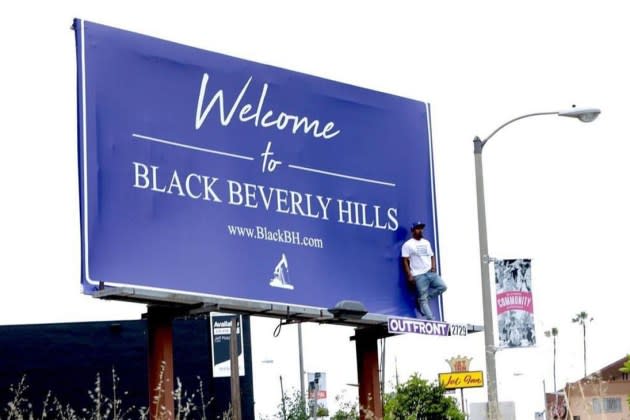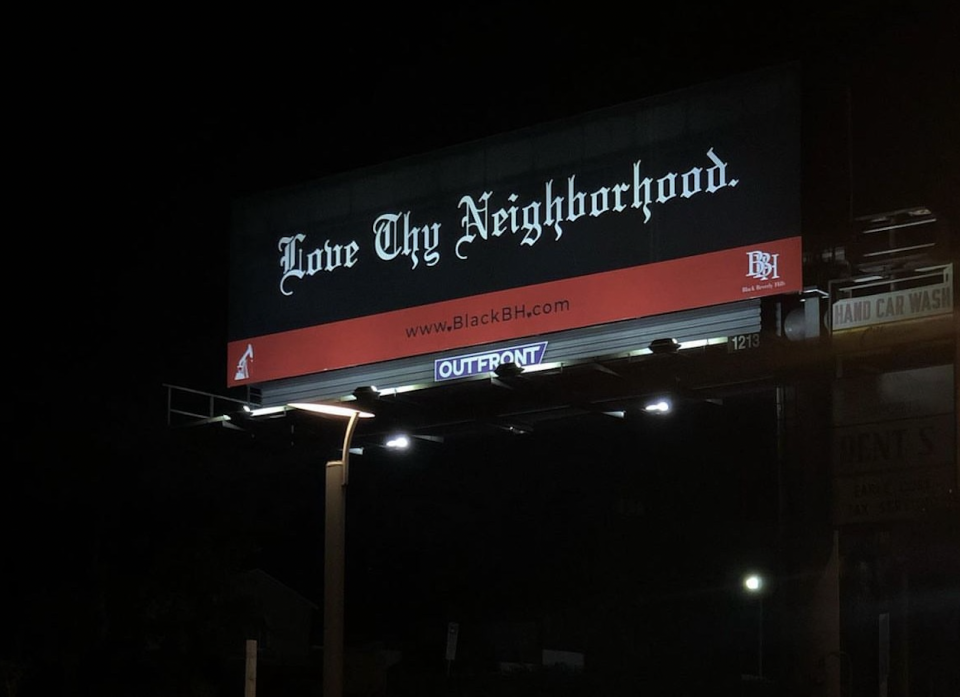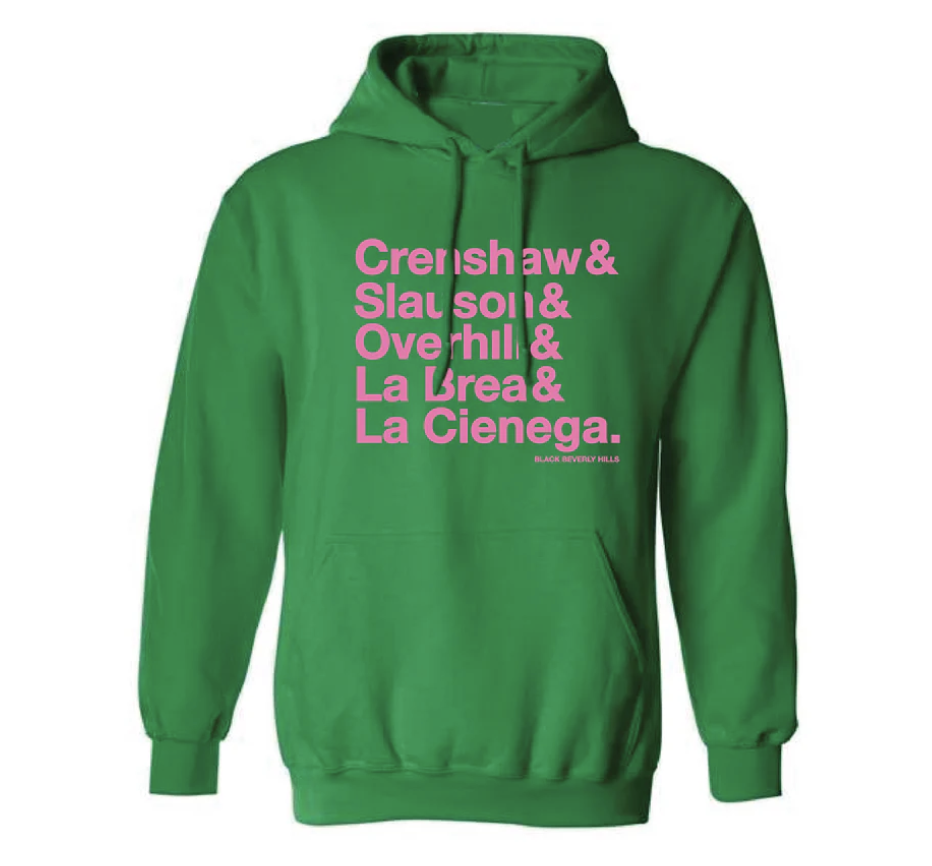Despite a Fight, South L.A.’s “Welcome to Black Beverly Hills” Billboard Comes Down

Historically Black Los Angeles has one less landmark that speaks to its cultural heritage. The iconic “Welcome to Black Beverly Hills” billboard, once proudly stationed near the neighborhood of Ladera Heights, has come down.
The creator of the billboard, Robert China Berry, says that he was forced to take down and move the billboard multiple times and is now seeking more permanent signage elsewhere in the area.
More from The Hollywood Reporter
Actor Nick Pasqual Charged for Alleged Knife Attack on Ex-Girlfriend, Makeup Artist Allie Shehorn
Hollywood Makeup Artist Out of ICU After Knife Attack Inside Her Home
Berry trademarked the term “Black Beverly Hills” in 2012 for his clothing brand, which honors the history and cultural importance of the Black community in the region. But the legacy of Black Beverly Hills goes back decades.
During the 1950s, amid a backdrop of segregation and systemic racism, the area encompassing Baldwin Hills, Ladera Heights, View Park and Windsor Hills emerged as a sanctuary for Black professionals, artists and entrepreneurs in Los Angeles. These neighborhoods became synonymous with prominence and achievement and were soon were dubbed the Black Beverly Hills within the African American community.
In the years before 1948, these areas — like much of Los Angeles (save for historic South Central) — excluded Black homeowners. But following the landmark Supreme Court ruling in 1948 that deemed racially restrictive housing covenants unconstitutional, affluent Black families were finally able to move into a number of areas from which they had been excluded.
Many Black celebrities have called this part of Los Angeles home, including entertainers like Ray Charles, Ike and Tina Turner, Lenny Kravitz and Debbie Allen. The neighborhoods also have been prominently featured in such popular films as Ray, Love and Basketball, Something New, You People, What’s Love Got to Do With It and more.
But when Berry — born and raised in View Park — launched his clothing line, not everyone was pleased.
Berry recalls that the city of Beverly Hills and the Beverly Hills Hotel both sent him cease-and-desist letters claiming that his logo violated trademark rights. He reached settlements with both and made “slight modifications” to his font.
During this time, Berry felt compelled to find ways to market the brand and bring attention to the Black Beverly Hills moniker.
In 2019, he commissioned a billboard at the intersection of Slauson and La Brea avenues that read, “Happy Holidays from Black Beverly Hills and friends,” later replacing it with the message, “Welcome to Black Beverly Hills,” intended as an inviting beacon to the area.

However, before long, Berry says that the billboard’s manager told him that the land it sat on was being sold and that the billboard would need to come down. Berry says he was offered another location a few blocks away at Slauson Avenue and Overhill Drive, a busy intersection that runs through the heart of the Windsor Hills area.
The “Welcome to Black Beverly Hills” billboard remained there from 2020 until February 2024. Over the years, the sign has showcased a range of messages, occasionally spotlighting other local Black businesses to bolster awareness and support for them.
However, Berry says he encountered complications earlier this year when a local business owner objected to the sign being positioned directly above her store.

Berry recalls being informed by the billboard manager that the sign must be taken down. Although an alternative location was proposed, Berry says the costs were three times higher. He soon initiated a GoFundMe campaign, rallying support from the community to “Save Our Billboard” and launching a petition that garnered nearly 2,500 signatures.
Berry believes the sign held significant cultural importance. “Every ethnic group has its own enclaves, for example, Chinatown, Koreatown, Little Tokyo, Little Ethiopia, Little Armenia, Cambodia Town, Little Persia, Little Italy, and even a German Town,” he says. “I feel the sign being taken down encourages accelerated gentrification and is also erasing the neighborhood’s history and Black population.”
Because of the rich Black history ingrained in the area, neighborhoods like View Park have been nominated for inclusion on the National Register of Historic Places. However, some residents harbor concerns that historic designation might be exploited to entice white buyers, who, facing soaring real estate costs elsewhere, may now show interest in neighborhoods they once disregarded.
Residents are developing new ways and spaces to celebrate the cultural significance and contributions of Black L.A. Destination Crenshaw is a new 1.3-mile-long open-air museum on Crenshaw Boulevard currently under construction. The project includes new parks, more than 100 commissioned works of art, street furniture and landscaping to honor and elevate the area’s history. The tagline on Destination Crenshaw’s website reads, “Celebrating Our Legacy. Building Our Future.”

For now, Berry is working on finding new ways to support the Black Beverly Hills brand and legacy. He recently put up a billboard at Slauson and La Brea avenues, but had to take it down in March because of the monthly $6,000 cost.
“I plan to further continue the clothing brand, advocate for more permanent signage and utilize my role in real estate and entertainment to increase Black homeownership in the community,” Berry says. “These efforts aim to preserve the area’s identity and support its Black residents amid ongoing changes.”

This story first appeared in the May 29 issue of The Hollywood Reporter magazine. Click here to subscribe.
Best of The Hollywood Reporter

